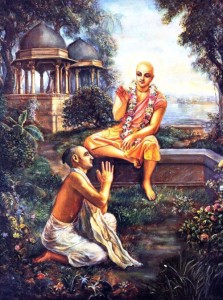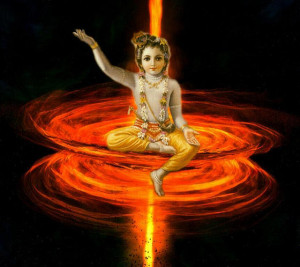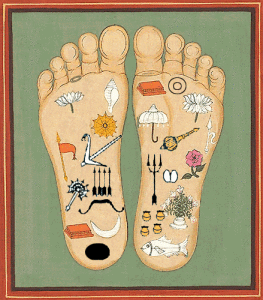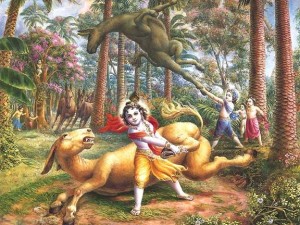Hare Krishna
31st January, 2015, Gurgaon
We recently did a short class based on the seminar by HH Bhakti Vijana maharaj called `Change the heart’. This is a wonderful seminar by maharaj and I have heard it multiple times, shared with numerous devotees, always hoping that some parts may get absorbed in my polluted consciousness. The seminar is in two parts, in the first part Maharaj explains why we must change our heart and quotes the below verse from SB 1.2.17
Translation
Certainly that heart is steel-framed which, in spite of one’s chanting the holy name of the Lord with concentration, does not change when ecstasy takes place, tears fill the eyes and the hairs stand on end.
Srila Prabhupada writes in his purport `The whole process of spiritual culture is aimed at changing the heart of the living being in the matter of his eternal relation with the Supreme Lord as subordinate servant, which is his eternal constitutional position. So with the progress of devotional service, the reaction of change in the heart is exhibited by gradual detachment from the sense of material enjoyment by a false sense of lording it over the world and an increase in the attitude of rendering loving service to the Lord…. It is expected by all means that by discharging regulated devotional service one must manifest the change of heart. If there is no such change, the heart must be considered steel-framed, for it is not melted even when there is chanting of the holy name of the Lord. We must always remember that hearing and chanting are the basic principles of discharging devotional duties, and if they are properly performed there will follow the reactional ecstasy with signs of tears in the eyes and standing of the hairs on the body. These are natural consequences and are the preliminary symptoms of the bhāva stage, which occurs before one reaches the perfectional stage of prema, love of Godhead.’
Maharaj then explained in brief on what is meant by changing of heart (we should change out thoughts, emotions and desires) ? Why the heart does not change so easily ? Why it changes quickly in case of some devotees and what are the symptoms of change of heart ? All this backed with interesting stories from various shastras. The first part of the seminar ends with the understanding as to how we can somehow change our thoughts and emotions but desires are most difficult to change as we ourselves don’t know what all desires are there in our subconscious mind.
I am writing a short summary on the second part of the seminar where maharaj explained how we can change our desires.
Maharaj quotes the famous verse from SB
śṛṇvatāḿ sva-kathāḥ kṛṣṇaḥ puṇya-śravaṇa-kīrtanaḥ
hṛdy antaḥ stho hy abhadrāṇi vidhunoti suhṛt satām
Translation
Śrī Kṛṣṇa, the Personality of Godhead, who is the Paramātmā [Supersoul] in everyone’s heart and the benefactor of the truthful devotee, cleanses desire for material enjoyment from the heart of the devotee who has developed the urge to hear His messages, which are in themselves virtuous when properly heard and chanted.
Srila Prabhupada writes in his purport that `Messages of the Personality of Godhead Śrī Kṛṣṇa are non different from Him. Whenever, therefore, offenseless hearing and glorification of God are undertaken, it is to be understood that Lord Kṛṣṇa is present there in the form of transcendental sound, which is as powerful as the Lord personally.’
The Lord is reciprocally respondent to His devotees. When He sees that a devotee is completely sincere in getting admittance to the transcendental service of the Lord and has thus become eager to hear about Him, the Lord acts from within the devotee in such a way that the devotee may easily go back to Him. The Lord is more anxious to take us back into His kingdom than we can desire. Most of us do not desire at all to go back to Godhead. Only a very few men want to go back to Godhead. But anyone who desires to go back to Godhead, Śrī Kṛṣṇa helps in all respects.
Maharaj said that this verse clearly says that when a devotee has developed the urge to hear His message then Lord Himself cleanses desire for material enjoyment from his heart. Hence reading Srimad Bhagavatam regularly we can change our desires and change our heart too. Maharaj said that though the verse says like this yet we do not not see too many devotees rolling on the ground in ecstasy ! Maharaj pointed out that though the verse says hearing' but Prabhupada qualifies the hearing tooffenseless hearing’ in his purport. Maharaj said that we have heard of offensive speaking but never heard about offensive hearing, what exactly is ‘offenseless hearing’ ? And if Prabhupada wrote it then it must have a deeper meaning.
Maharaj then quoted the last line of SB 1.1.2 verse
sadyo hṛdy avarudhyate ‘tra kṛtibhiḥ śuśrūṣubhis tat-kṣaṇāt
Maharaj said this verse too says as soon as one hears the message of Bhāgavatam, Krishna becomes a resident of our heart. But there is a very important condition which is included which we usually forget. Maharaj then quoted Srila Sridhar Swami commentary on this verse where in Srila Sridhar Swami wrote that `if someone is not properly hearing then it will take a lot of time’. We may hear again and again but nothing substantial will change in our heart.
So what is is this proper hearing ?
Maharaj said that the conditions for properly hearing are given in Bahagavat Mahatmayam'. Maharaj quoted the below verse fromBahagavat Mahatmayam’ and said this verse holds the key on how to hear Bhāgavatam.
िवशवासो गुरवाकयेषु सविसमनदीनतवभावना ।
मनोदोषजयशचैव कथायां िनशचला मितः ॥
Maharaj explained that how this verse speaks of four conditions on how to hear properly. These are
1. िवशवासो गुरवाकयेषु : Faith on the words of our Guru, This means complete, absolute trust and surrender to the words of Guru. we can also take it as that we must take to our heart what we heard and apply in our life.
- सविसमनदीनतवभावना: `Dina bahavana’ means that I am very fallen. We should not think O ! I have heard this topic so many times before or I can speak better than him !! The mood of humility must be there while listening.
- मनोदोष : Defects or faults of our mind. The mind is extremely restless it doesn’t want to do a single thing, it wants to jump from one place to another, from one activity to another. Maharaj said that’s why people like internet net so much as we can go anywhere without being absorbed or concentrated on anything. We have to conquer our mind, atleast for the time we are in the class of Bhagavatam.
Maharaj narrated a story about Madhavacharya and a bull in his ashram. This Bull had a unique habit that he would stop chewing whenever Madhavacharya would start speaking. Later on this bull took birth as Jayatiratha, a learned vaishanava, and wrote long commentaries on Madhavacharya’s teachings.
Maharaj said similarly we need to train our mind to stop chewing and hear attentively.
- िनशचला मितः : `Matih’ means intelligence, concentrated hearing by using intelligence.
Maharaj then spoke how we can listen Srimad Bhagavatam in the mode of ignorance, passion and goodness. Maharaj elaborated only on the mode of passion and spoke the below three ways where devotees listen in the mode of passion. In all such cases the heart does not change very quickly.
What is the motivation of hearing Srimad Bhagavatam ?
Visaya : I hear with the expectation that the speaker will entertain me, I am going to listen to this particular speaker because his lectures are laced with light stories and he will entertain me by cracking jokes, etc. otherwise I am bored.
Yasha : It means desire for fame . We hear with the mentality this is very good, I will speak this on the next given opportunity. We are not hearing with the sincere heart that something very important is being said to me which I have to apply, we are only hearing to repeat it afterwords because this is an interesting point, and it will make me a famous preacher !
Aishwarya: It comes from the root word ishwara so it also means power (general meaning is opulence). Sometimes we hear with this motivation or desire that when I hear this and I will repeat it. I will then obtain the power or influence over people. I will acquire this ability to influence other people and that will bring power and opulence to me.
Maharaj said that all the above three points are completely against the humble mood in which we should hear Srimad Bhagavatam. We must know that if I have to change my heart then I will have to change my attitude while hearing.
Maharaj came back to the most important point of using our intelligence in hearing, िनशचला मितः. Maharaj stressed that we have to hear but only hearing is not enough but the process of hearing should be such that it would ignite in me the process of deliberating and thinking about what I have heard. The process of hearing is only successful as much as it turns on the thinking process with in myself. That means I apply my intelligence in such a way on what I heard as to understand what it really means for me and how can I apply apply it in my life. In this way my intelligence is being turned on, and if it’s being turned on, then only the process of hearing will be successful in changing our heart.
Maharaj ended the seminar with the famous story of Dhundhukari from Bhagavata mahatmayam in Padama Purana. This is a long story, briefly put Dhundhukari was a very sinful person. He died a horrible premature death and thus became a ghost. When his pious brother, Gokarna, comes back, he finds out that his brother has become a ghost. He then organised a Bahagavatam `saptah’ to liberate his brother, who listens the katha sitting inside a bamboo. After the 7th day when the katha was over Vishnuduta came from Vaikuntha to take Dhundhukari back to Vaikuntha. Gokarna is very happy for his brother but is very surprised that there were others, including himself, who also listened with attention and yet why only Dhundhukari is going back to Godhead. Being questioned Vishnudutas reply that though all the assembled devotees heard the katha with attention but when they went back to their homes none of them thought about what they heard. It was only Dhundhukari would think about he had heard and what it means for him, so much so that we he won’t even sleep in the night.
Maharaj said that many a times we hear a great lecture and we are all impressed and we praise the lecture and the speaker but after a few days or even after few hours if someone were to ask us what was the lecture about we are unable to recollect it even partially.
Maharaj said that by the process of meditation on what he had heard, this particular process of `mannan’, when we think about we heard and and then try to understand how it applies to us, continued for the ghost he burned of all his previous karmas ! Maharaj again stressed that it is this thinking, and not just the hearing, which becomes a sword by which we can cut the knots of our karma. At this stage the inspiration becomes internal and it changes our heart !
I strongly request all the readers to kindly hear this wonderful seminar, you can download the same by clicking it HERE.
All glories to HH Bhakti Vijnana maharaj
All glories to Srimad Bhagavatam.
All glories to Srila Prabhupada.





